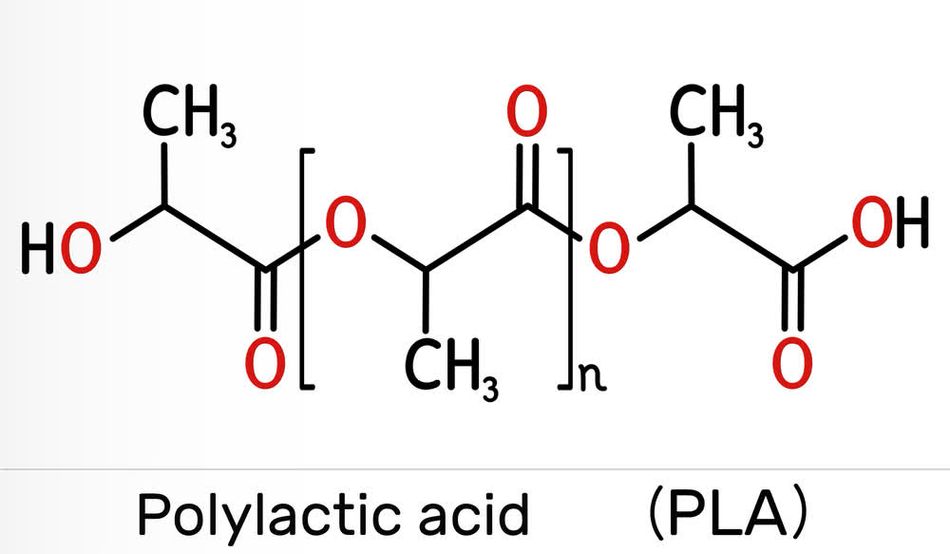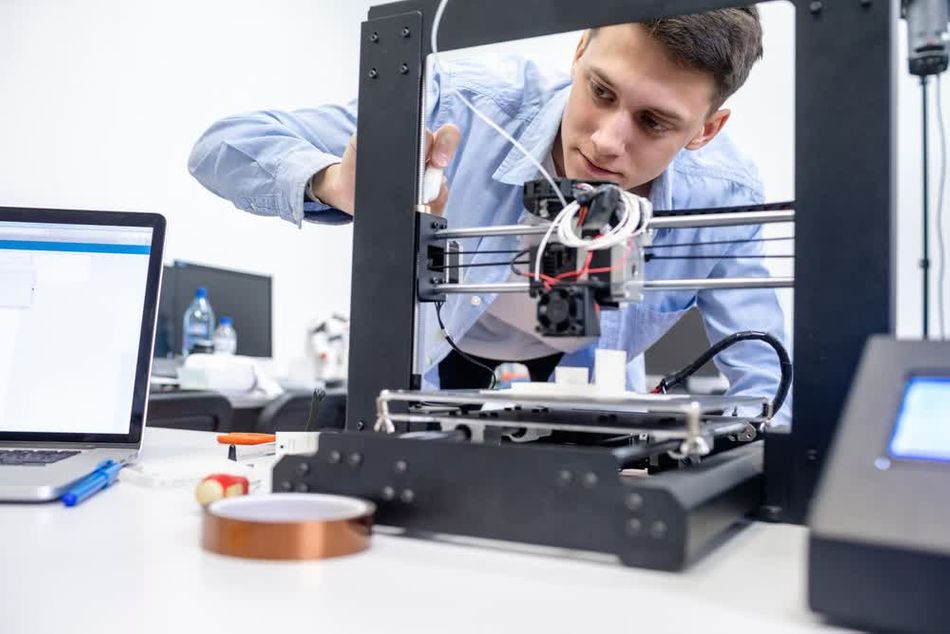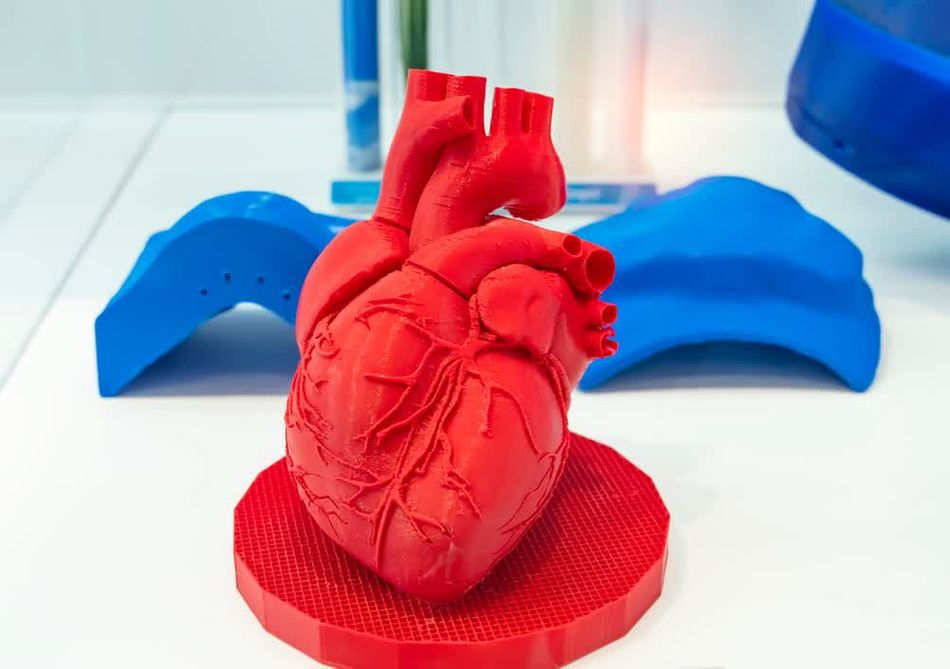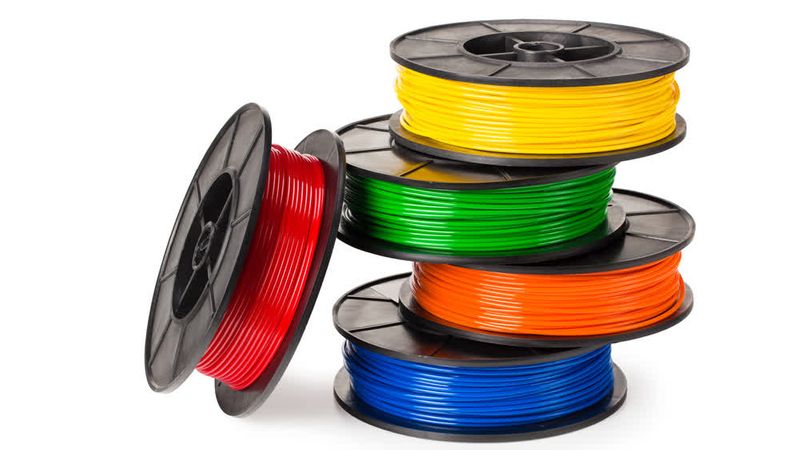What is PLA Filament? Composition, Advantages, Applications
What is PLA filament and why is it so popular for entry-level 3D printing and beyond? This article covers the basics of Polylactic Acid.
What is PLA filament? Polylactic Acid, to give the material its full name, is a thermoplastic polymer derived from renewable resources such as corn starch or sugarcane.[1] A favorite among both hobbyists and professionals in the additive manufacturing industry, PLA’s popularity can be attributed to its combination of user-friendliness, versatility, and eco-friendly properties.
As 3D printing technology continues to evolve, PLA filament stands out for its low melting point, minimal warping, and excellent layer adhesion, making it ideal for a wide range of applications. From rapid prototyping to creating intricate artistic designs, PLA offers impressive print quality and dimensional accuracy. Moreover, its biodegradability and lower carbon footprint compared to petroleum-based alternatives make it an attractive choice for environmentally conscious users.
In the following sections, we will delve deeper into the question of “What is PLA filament?” In doing so, we will examine the composition, properties, and myriad applications of PLA filament that have made it a reliable workhorse in the 3D printing landscape.
What is PLA Filament?
PLA filament is a biodegradable thermoplastic material used primarily in 3D printing. PLA, which stands for Polylactic Acid, is a polymer derived from renewable plant-based resources such as corn starch or sugarcane. This versatile material is a thermoplastic, meaning it becomes pliable when heated and solidifies upon cooling, making it ideal for the additive manufacturing process.
In its printable filament form, PLA comes in the form of a long, thin thread of plastic wound onto a spool. (The material is also sold in pellet form for large-format 3D printing and injection molding.) Filament spools are available in various diameters, typically 1.75mm or 2.85mm, to accommodate different 3D printer models. The filament is fed into a 3D printer's extruder, where it is heated and deposited layer by layer to create three-dimensional objects.
What sets PLA filament apart from many other 3D printing materials is its eco-friendly nature. As a plant-based polymer, PLA is biodegradable under specific industrial composting conditions. This characteristic, combined with its low toxicity and minimal fumes during printing, makes PLA a popular choice for environmentally conscious makers and businesses alike.
Many material suppliers offer PLA filament. Hatchbox offers reliable and affordable PLA, favored by both beginners and experts. Polymaker's range includes the durable PolyMax PLA and versatile PolyLite PLA. Prusament by Prusa Research is celebrated for its high precision and quality standards. eSun offers diverse PLA options, including the enhanced PLA+. ColorFabb is known for unique blends like PLA/PHA, which add flexibility and durability. MatterHackers produces PRO Series PLA in vibrant colors.
Recommended reading: PLA Smoothing: How to Smooth 3D Prints
The Science Behind PLA: Composition and Properties

Polylactic Acid (PLA) is a linear aliphatic polyester composed of lactic acid building blocks.[2] Its molecular structure consists of repeating units of lactic acid monomers, linked together through ester bonds.
PLA is derived from renewable plant-based sources rich in carbohydrates, such as corn starch, cassava roots, or sugar cane. The production process begins with the extraction of starch from these plants, which is then converted into glucose through enzymatic hydrolysis. Glucose undergoes fermentation by microorganisms to produce lactic acid. This lactic acid is then polymerized through a condensation reaction to form PLA.
PLA filament possesses a unique set of physical properties that contribute to its popularity in 3D printing. The main physical properties of PLA include:
Tensile Strength: 50-70 MPa, providing good structural integrity for printed objects.
Density: Approximately 1.24 g/cm³, resulting in lightweight yet sturdy prints.
Melting Point: 150-160°C, allowing for easy extrusion at lower temperatures.
Glass Transition Temperature: 60-65°C, affecting the heat resistance of printed parts.
Elongation at Break: 2.5-6%, indicating moderate flexibility.
Biodegradability: Compostable under industrial conditions within 3-6 months.
Comparison of PLA properties with other common plastics:
Property | PLA | ABS | PETG | Nylon |
Tensile Strength (MPa) | 50-70 | 40-60 | 50-70 | 70-85 |
Density (g/cm³) | 1.24 | 1.04 | 1.27 | 1.13 |
Melting Point (°C) | 150-160 | 210-240 | 230-250 | 220-260 |
Biodegradability | Yes | No | No | No |
Print Bed Temperature (°C) | 20-60 | 80-110 | 70-90 | 70-100 |
PLA's properties make it particularly suitable for 3D printing due to its low melting point, which allows for easier extrusion and reduced energy consumption during printing. Its low shrinkage rate and minimal warping contribute to improved dimensional accuracy and better adhesion to the print bed. The semi-crystalline nature of PLA contributes to its shrinkage resistance.[3] Additionally, PLA's good layer adhesion and low odor emission during printing enhance its usability in various settings, including home and office environments.
Tough PLA (PLA+) and PLA Blends
Strengthened PLA variants, sometimes marketed as “tough PLA” or “PLA+,” are modified versions of standard PLA designed to enhance the material’s mechanical properties, making it more suitable for functional and durable applications. Unlike regular PLA, which is known for its brittleness, PLA+ incorporates additives that improve its impact resistance, flexibility, and tensile strength. These enhancements allow tough PLA to withstand greater stress and strain. PLA+ retains the ease of printing associated with standard PLA, including low warping and minimal odor.
PLA blends, created by combining PLA with other thermoplastics, offer enhanced properties that may make them suitable for a wider range of applications than standard PLA alone. These blends can include materials like ABS, PETG, or TPU, each contributing distinct advantages. For instance, PLA blended with ABS results in a filament with increased heat resistance and durability, whereas blending PLA with TPU creates a more flexible and impact-resistant material, suitable for items like phone cases or wearable parts.
Mastering 3D Printing with PLA

PLA is one of the easiest materials to print, although it requires specific printing conditions to achieve optimal results. The extruder temperature typically ranges from 180°C to 220°C, with 200°C being a common starting point. The print bed temperature for PLA is relatively low, usually between 20°C and 60°C. Some prints may not require a heated bed at all, but a slightly warm bed (around 40°C) can improve first layer adhesion.
Adequate cooling of PLA prints helps prevent sagging or drooping, especially in overhanging areas or intricate details. Most 3D printers come equipped with part cooling fans, which should be set to 100% after the first few layers. This rapid cooling ensures that each layer solidifies quickly, maintaining the print's structural integrity and surface quality.
To achieve the best print quality with PLA, consider the following tips:
Use a quality build surface: PLA adheres well to various surfaces, including glass, PEI, or specialized build plates.
Adjust layer height: Start with a 0.2mm layer height and adjust based on your print's requirements for detail or speed.
Optimize print speed: A speed of 40-60 mm/s works well for most PLA prints. Slower speeds may improve quality but increase print time.
Fine-tune retraction settings: Proper retraction prevents stringing and oozing, typically around 5mm at 40mm/s for direct drive extruders.
Maintain filament quality: Store PLA in a cool, dry place to prevent moisture absorption, which can affect print quality.
Calibrate your extruder: Ensure proper filament flow by calibrating your extruder's steps per millimeter.
Use appropriate infill: 15-20% infill is sufficient for most prints, but adjust based on the object's intended use.
By optimizing these conditions and following these tips, you can significantly enhance the quality and success rate of your PLA 3D prints.
Recommended reading: PLA Bed Temperature & Print Temperature Settings
Advantages and Disadvantages of PLA in 3D Printing
PLA filament offers numerous advantages in 3D printing, making it a popular choice for both beginners and experienced users. Its unique properties contribute to high-quality prints and user-friendly operation.
Key advantages of PLA in 3D printing include:
Low warping: PLA has minimal thermal expansion, reducing the risk of print deformation.
Excellent layer adhesion: PLA layers bond well, resulting in strong, cohesive prints.
Low printing temperature: PLA extrudes at lower temperatures, reducing energy consumption and wear on printer components.
Minimal odor: Unlike some other filaments, PLA produces little to no unpleasant smell during printing.
High print speed: PLA can be printed at relatively high speeds without significant quality loss.
Wide color range: PLA is available in a vast array of colors and finishes, including translucent and glow-in-the-dark options.
Biodegradability: PLA is compostable under industrial conditions, making it more environmentally friendly than other plastics.
PLA's low warping property allows for printing large, flat surfaces without the need for a heated bed, reducing equipment costs and energy consumption. Its excellent layer adhesion contributes to the structural integrity of printed objects, making it suitable for functional parts and prototypes.
The low printing temperature of PLA (typically 180-220°C) not only saves energy but also allows for safer operation, especially in educational settings. This characteristic, combined with its minimal odor, makes PLA ideal for use in homes, offices, and schools.
While PLA filament offers numerous advantages in 3D printing, it also comes with certain limitations and challenges that users should be aware of:
Low heat resistance: PLA has a low glass transition temperature (60-65°C), making it unsuitable for high-temperature applications. Workaround: For parts requiring higher heat resistance, consider post-processing techniques like annealing or using PLA blends with higher temperature resistance.
Brittleness: PLA can be brittle, especially when exposed to impact or stress. Solution: Adjust print settings for higher infill density or use PLA blends with impact modifiers for improved toughness.
Limited outdoor durability: PLA degrades when exposed to UV light and moisture, making it less suitable for outdoor applications. Solution: For outdoor use, consider coating PLA prints with UV-resistant sealants or opt for more weather-resistant materials like ASA or PETG.
Post-processing challenges: PLA is difficult to sand or smooth compared to other materials like ABS. Workaround: Use filler primers before painting or explore chemical smoothing techniques specifically designed for PLA.
Applications of PLA Filament

PLA filament has a wide range of applications due to its ease of use, biodegradability, and versatility. Its low melting temperature and minimal warping make it an ideal choice for both novice and experienced users, enabling the creation of diverse objects with varying degrees of complexity.
Prototypes
One of the most common applications of PLA filament is in prototyping. Engineers and designers use PLA to quickly produce prototypes of their designs, allowing for rapid iteration and testing. The ease of printing with PLA, combined with its relatively low cost, makes it a practical choice for creating functional prototypes and models that can be used to test form, fit, and function before moving to more expensive materials or manufacturing processes.
Education
PLA is also extensively used in the education sector. Schools and universities leverage 3D printing with PLA to enhance learning experiences in STEM (science, technology, engineering, and mathematics) programs. Students can design and print their projects, gaining hands-on experience with 3D modeling and printing technology. The biodegradability of PLA adds an environmentally friendly aspect to its use in educational settings, aligning with sustainability goals.
Art and Design
In the realm of art and design, PLA filament is favored for its ability to produce detailed and aesthetically pleasing objects. Artists use PLA to create intricate sculptures, jewelry, and decorative items. The wide range of available colors and finishes, including matte, glossy, and even metallic, allows for a high degree of customization and creativity. Moreover, specialty PLA blends, such as those infused with wood fibers or metal particles, enable artists to achieve unique textures and effects.
Medicine
The medical field has also embraced PLA filament for various applications. PLA’s biocompatibility makes it suitable for creating custom medical devices, such as prosthetics, braces, and implants. It also has uses in tissue engineering scaffolds and drug delivery systems. Additionally, PLA is used in the production of anatomical models for surgical planning and education. These models can be printed to precise dimensions, providing surgeons with a tangible reference for complex procedures.
Makers
Hobbyists and makers benefit greatly from the versatility of PLA filament. It is commonly used to print a wide array of items, from custom toys and gadgets to household items and replacement parts. The ease of printing with PLA, coupled with its affordability, makes it an attractive option for personal projects and DIY enthusiasts.
Packaging
Lastly, the packaging industry utilizes PLA filament for creating biodegradable and compostable packaging solutions. With increasing emphasis on reducing plastic waste, PLA offers an eco-friendly alternative for producing packaging materials that can break down naturally over time, contributing to environmental sustainability.
The Green Choice: Environmental Impact of PLA
PLA's biodegradability sets it apart from conventional plastics, offering a more environmentally friendly alternative for various applications. The biodegradation process of PLA occurs through hydrolysis, where water molecules break down the polymer chains into smaller fragments. This initial step is followed by microbial action, where microorganisms in the environment further break down these fragments into carbon dioxide, water, and biomass.
The biodegradation process of PLA typically involves several stages:
Hydrolysis: Water molecules attack the ester bonds in the PLA polymer chain.
Fragmentation: The polymer breaks into smaller oligomers and monomers.
Assimilation: Microorganisms consume these smaller molecules as a food source.
Mineralization: The final breakdown products (CO2, H2O, and biomass) are released into the environment.
Industrial composting is required for the efficient biodegradation of PLA due to the specific conditions needed. Under these controlled industrial composting conditions, PLA can biodegrade within 3-6 months. In contrast, traditional plastics like polyethylene (PE) or polypropylene (PP) can take hundreds of years to degrade, if they degrade at all.
It's important to note that while PLA is biodegradable under industrial composting conditions, it does not readily biodegrade in home composting systems or natural environments due to the lack of sustained high temperatures and controlled conditions. In landfills or marine environments, PLA may persist for much longer periods, though still significantly less than traditional plastics.
Carbon Footprint and Sustainability
Lifecycle assessment (LCA) of PLA production reveals a complex interplay of environmental impacts across various stages, from raw material extraction to end-of-life disposal. The production of PLA begins with the cultivation of corn or other starch-rich crops, followed by fermentation to produce lactic acid, and finally polymerization to create PLA.
Key stages in PLA production and their environmental implications:
Crop cultivation: Requires land use, water, and potentially pesticides and fertilizers.
Starch extraction: Involves energy-intensive processes to isolate starch from crops.
Fermentation: Converts starch to lactic acid, requiring energy and producing CO2 as a byproduct.
Polymerization: Energy-intensive process to create PLA from lactic acid monomers.
End-of-life: Biodegradation in industrial composting facilities or recycling.
When comparing energy requirements, PLA generally shows lower energy consumption compared to petroleum-based plastics. Studies indicate that PLA production requires 25-55% less energy than conventional plastics like polyethylene terephthalate (PET) or polystyrene (PS). This energy efficiency translates to a reduced carbon footprint, with PLA production emitting approximately 1.3 kg CO2 eq/kg of polymer, compared to 2.0 kg CO2 eq/kg for PET.
However, the carbon footprint of PLA can vary significantly depending on feedstock source and production methods. For instance, using agricultural waste as feedstock instead of purpose-grown crops can further reduce the carbon footprint. Additionally, the use of renewable energy sources in PLA production can substantially decrease its overall environmental impact.
Researchers believe that the environmental performance of PLA can be improved through better sugarcane farming practices, higher efficiency bagasse boilers, reduced auxiliary chemical use, and greater use of renewable energy when converting sugar to PLA.[4]
Conclusion
Key advantages of PLA filament include biodegradability, low warping tendency, and ease of use, making the material ideal for beginners and environmentally conscious users. PLA also offers excellent resolution and comes available in a wide range of colors and finishes, often at a very low price point. However, limitations such as low heat resistance and brittleness should be kept in mind, especially for functional parts.
Frequently Asked Questions
Is PLA filament food-safe?
PLA is generally considered food-safe, but the safety of the final product depends on additives and colorants used. For food contact applications, use FDA-approved PLA and ensure proper printing conditions to prevent bacterial growth in layer lines.
How long does PLA take to biodegrade?
Under industrial composting conditions (high temperature and humidity), PLA can biodegrade in 3-6 months. However, in normal environmental conditions or landfills, it may take several years to decades.
Can PLA be recycled?
Yes, PLA can be recycled, but it requires specialized facilities. It's not commonly accepted in standard recycling streams. Some 3D printing enthusiasts grind and reuse PLA, though this may affect print quality.
What are the best storage conditions for PLA filament?
Store PLA in a cool, dry place, ideally in an airtight container with desiccant. Optimal conditions are 10-30°C (50-86°F) with relative humidity below 50% to prevent moisture absorption. High humidity can cause PLA to absorb moisture, leading to poor print quality, bubbling, and stringing.
Can PLA be used for outdoor applications?
PLA is not ideal for long-term outdoor use as it degrades when exposed to UV light and moisture. For outdoor applications, consider using ABS or PETG, or apply a protective coating to PLA prints.
Is it possible to paint PLA 3D prints?
Yes, PLA can be painted, but it may require surface preparation like sanding and priming for better paint adhesion. Acrylic paints work well with PLA, and spray paints designed for plastics can also be effective.
References
[1] Fatchurrohman N, Muhida R. From Corn to Cassava: Unveiling PLA Origins for Sustainable 3D Printing. Jurnal Teknologi. 2023 Dec 31;13(2):87-93.
[2] de Albuquerque TL, Júnior JE, de Queiroz LP, Ricardo AD, Rocha MV. Polylactic acid production from biotechnological routes: A review. International journal of biological macromolecules. 2021 Sep 1;186:933-51.
[3] Lluch-Cerezo J, Meseguer MD, García-Manrique JA, Benavente R. Influence of thermal annealing temperatures on powder mould effectiveness to avoid deformations in ABS and PLA 3D-printed parts. Polymers. 2022 Jun 27;14(13):2607.
[4] Morão A, De Bie F. Life cycle impact assessment of polylactic acid (PLA) produced from sugarcane in Thailand. Journal of Polymers and the Environment. 2019 Nov;27(11):2523-39.
Table of Contents
What is PLA Filament?The Science Behind PLA: Composition and PropertiesTough PLA (PLA+) and PLA BlendsMastering 3D Printing with PLAAdvantages and Disadvantages of PLA in 3D PrintingApplications of PLA FilamentPrototypesEducationArt and DesignMedicineMakersPackagingThe Green Choice: Environmental Impact of PLACarbon Footprint and SustainabilityConclusionFrequently Asked QuestionsReferences
